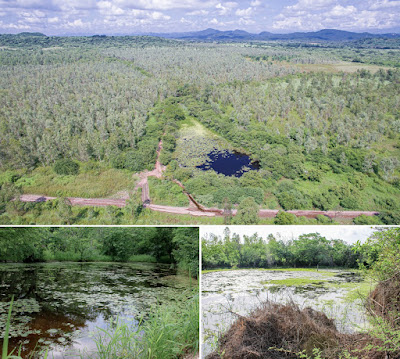 |
| Kinosternon cora Loc-Barragán, Reyes-Velasco, Woolrich-Piña, Grünwald, Anaya, Rangel-Mendoza & López-Luna, 2020 |
Abstract
We describe a new species of mud turtle of the genus Kinosternon from the Pacific Coastal Plain of the Mexican states Sinaloa and Nayarit. The new species shares morphological characters with the recently described Kinosternon vogti, which are unique to these two turtles and separate them from the other species of the genus. The new species differs from K. vogti by skin coloration, size, and the scutellation of both carapace and plastron. We also present a molecular phylogeny of the family Kinosternidae based on two mitochondrial and four nuclear loci. Our results show that the new species is most closely related to K. vogti, and together they form the sister group to the K. hirtipes and K. integrum species groups of Kinosternon.
Keywords: Reptilia; freshwater turtle sp. nov.; endemic; Sinaloa; Nayarit; Pacific Coastal Plain
 |
| Head patterns of Kinosternon cora sp. nov. A: Female holotype, MZFC-HE 35627, B: Male paratype, MZFC-HE 35629. Unscaled images. Photo by M. A. López-Luna. |
Kinosternon cora sp. nov.
Cora Mud Turtle, Casquito cora, Chacuanita cora
Diagnosis—A small Kinosternon, the largest known specimen is a female (CL=107.7 mm). This species is unique among Kinosternon of western Mexico, except K. vogti, of which it is a sister species, by possessing a very reduced and weakly kinetic plastron; a narrow bridge; and a proportionally wide carapace. We describe the diagnostic characteristics of Kinosternon cora with the species present on the Mexican Pacific versant (Table 2).
.....
 |
| Male paratype of Kinosternon cora sp. nov. MZFC-HE 35629. Dorsal and ventral view. Black line represents 50 mm. Photo by M. A. López-Luna. |
Geographic distribution and habitat— Kinosternon cora inhabits low elevations from 10–30 m asl on the
Pacific Coastal Plain adjacent to the foothills of the Sierra Madre Occidental. The predominant type of vegetation
is tropical deciduous forest, with trees of 15–25 m in height. Along riparian areas tropical semi-deciduous forest is
present, with Enterolobium sp., Ficus sp. and Taxodium mucronatum trees, which may reach a height of 30 m or
more. Many trees and shrubs carry epiphytes and parasites. Eucalyptus crops have been planted in a large area near
the type locality of Kinosternon cora (Fig. 7).
Etymology— The specific epithet is derived from the name “Cora”, the Native-Mexican ethnic group that is
most widespread in Nayarit. The ethnic Cora population is concentrated in the municipalities of El Nayar, Acaponeta, Rosamorada and Ruiz, all of which are in Nayarit, the state where this new species was first discovered in
1962.
Jesús A. Loc-Barragán, Jacobo Reyes-Velasco, Guillermo A. Woolrich-Piña, Christoph I. Grünwald, Myriam Venegas de Anaya, Judith A. Rangel-Mendoza and Marco A. López-Luna. 2020. A New Species of Mud Turtle of Genus Kinosternon (Testudines: Kinosternidae) from the Pacific Coastal Plain of Northwestern Mexico. Zootaxa. 4885(4); 509–529. DOI: 10.11646/zootaxa.4885.4.3
RESUMEN: Describimos una nueva especie de tortuga casquito del género Kinosternon de la Llanura Costera del Pacifico Mexicano en
los estados de Sinaloa y Nayarit. La nueva especie comparte caracteres morfológicos con Kinosternon vogti, separandolas de
las otras especies del género. Las diferencias entre la nueva especie y K. vogti incluyen la coloración, tamaño, y proporciones
en los escudos del caparazón y el plastrón. También presentamos una filogenia molecular de la familia Kinosternidae basada
en dos genes mitocondriales y cuatro nucleares. Nuestros resultados muestran que la nueva especie está más emparentada
con K. vogti, y juntos estas especies forman el grupo hermano de los grupos de especies K. hirtipes y K. integrum.
Palabras claves: Reptilia; Tortuga de agua dulce sp. nov.; endémica; Sinaloa; Nayarit; Llanura Costera del Pacífico






